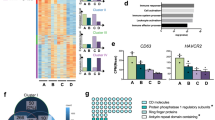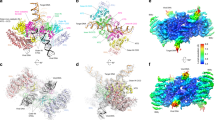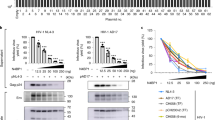Abstract
Human T-cell leukemia/lymphoma virus type 1 (HTLV-1) persists despite a vigorous virus-specific host immune response, and causes adult T-cell leukemia and lymphoma in approximately 2% of infected individuals. Here we report that HTLV-1 has evolved a genetic function to restrict its own replication by a novel post-transcriptional mechanism. The HTLV-1-encoded p30II is a nuclear-resident protein that binds to, and retains in the nucleus, the doubly spliced mRNA encoding the Tax and Rex proteins. Because Tex and Rex are positive regulators of viral gene expression1,2, their inhibition by p30II reduces virion production. p30II inhibits virus expression by reducing Tax and Rex protein expression.
This is a preview of subscription content, access via your institution
Access options
Subscribe to this journal
Receive 12 print issues and online access
$209.00 per year
only $17.42 per issue
Buy this article
- Purchase on Springer Link
- Instant access to full article PDF
Prices may be subject to local taxes which are calculated during checkout




Similar content being viewed by others
References
Ahmed, Y.F., Hanly, S.M., Malim, M.H., Cullen, B.R. & Greene, W.C. Structure-function analyses of the HTLV-I Rex and HIV-1 Rev RNA response elements: insights into the mechanism of Rex and Rev action. Genes Dev. 4, 1014–1022 (1990).
Smith, M.R. & Greene, W.C. Identification of HTLV-I tax trans-activator mutants exhibiting novel transcriptional phenotypes. Genes Dev. 4, 1875–1885 (1990).
Felber, B.K., Paskalis, H., Wong-Staal, F. & Pavlakis, G.N. The pX protein of HTLV-I is a transcriptional activator of its long terminal repeats. Science 229, 675–679 (1985).
Muchardt, C., Seeler, J.S. & Gaynor, R.B. Regulation of HTLV-I gene expression by tax and AP-2. New Biol. 4, 541–550 (1992).
Sodroski, J.G., Rosen, C.A. & Haseltine, W.A. Transacting transcriptional activation of the long terminal repeat of human T lymphotropic viruses in infected cells. Science 225, 381–385 (1984).
Franchini, G., Nicot, C. & Johnson, J.M. Seizing of T-cells by human T-cell leukemia/lymphoma type 1. in Advances in Cancer Research (eds. Vande Woude, G.F. & Klein, G.) 69–132 (Academic Press, San Diego, 2003).
Seiki, M., Hikikoshi, A., Taniguchi, T. & Yoshida, M. Expression of the pX gene of HTLV-I: general splicing mechanism in the HTLV family. Science 228, 1532–1534 (1985).
Goon, P.K. et al. High frequencies of Th1-type CD4+ T cells specific to HTLV-1 Env and Tax proteins in patients with HTLV-1-associated myelopathy/tropical spastic paraparesis. Blood 99, 3335–3341 (2002).
Jacobson, S., Shida, H., McFarlin, D.E., Fauci, A.S. & Koenig, S. Circulating CD8+ cytotoxic T lymphocytes specific for HTLV-I pX in patients with HTLV-I associated neurological disease. Nature 348, 245–248 (1990).
DiMaio, D. & Coen, D.M. Replication strategies of DNA viruses. in Fields Virology (eds. Fields, B.N., Knipe, D.M. & Howley, P.M.) 119–132 (Lippincott-Raven, Philadelphia, 1996).
Nicot, C. et al. Establishment of HTLV-I-infected cell lines from French, Guianese and West Indian patients and isolation of a proviral clone producing viral particles. Virus Res. 30, 317–334 (1993).
Derse, D., Mikovits, J., Waters, D., Brining, S. & Ruscetti, F. Examining the molecular genetics of HTLV-I with an infectious molecular clone of the virus and permissive cell culture systems. J. Acquir. Immune. Defic. Syndr. Hum. Retrovirol. 12, 1–5 (1996).
Kimata, J.T., Wong, F.H., Wang, J.J. & Ratner, L. Construction and characterization of infectious human T-cell leukemia virus type 1 molecular clones. Virology 204, 656–664 (1994).
Hiscott, J., Kwon, H. & Genin, P. Hostile takeovers: viral appropriation of the NF-κB pathway. J. Clin. Invest. 107, 143–151 (2001).
Koralnik, I. et al. Protein isoforms encoded by the pX region of the human T-cell leukemia/lymphotropic virus type I. Proc. Natl. Acad. Sci. USA 89, 8813–8817 (1992).
Princler, G.L., Julias, J.G., Hughes, S.H. & Derse, D. Roles of viral and cellular proteins in the expression of alternatively spliced HTLV-1 pX mRNAs. Virology, 317, 136–145 (2003).
Aldovini, A., De Rossi, A., Feinberg, M.B., Wong-Staal, F. & Franchini, G. Molecular analysis of a deletion mutant provirus of type I human T-cell lymphotropic virus: evidence for a doubly spliced x-lor mRNA. Proc. Natl. Acad. Sci. USA 83, 38–42 (1986).
Wachsman, W. et al. HTLV X-gene product: requirement for the env methionine initiation codon. Science 228, 1534–1537 (1985).
Kiyokawa, T. et al. p27x-III and p21x-III, proteins encoded by the pX sequence of human T-cell leukemia virus type I. Proc. Natl. Acad. Sci. USA 82, 8359–8363 (1985).
Koralnik, I.J., Fullen, J. & Franchini, G. The p12I, p13II, and p30II proteins encoded by human T-cell leukemia/lymphotropic virus type I open reading frames I and II are localized in three different cellular compartments. J. Virol. 67, 2360–2366 (1993).
Meyer, B.E. & Malim, M.H. The HIV-1 Rev trans-activator shuttles between the nucleus and the cytoplasm. Genes Dev. 8, 1538–1547 (1994).
Cullen, B.R. Regulation of HIV-1 gene expression. FASEB J. 5, 2361–2368 (1991).
Sambrook, J., Fritsch, E.F. & Maniatis, T. Molecular Cloning: A Laboratory Manual (Cold Spring Harbor Laboratory Press, Cold Spring Harbor, 1989).
Stauber, R., Gaitanaris, G.A. & Pavlakis, G.N. Analysis of trafficking of Rev and transdominant Rev proteins in living cells using green fluorescent protein fusions: transdominant Rev blocks the export of Rev from the nucleus to the cytoplasm. Virology 213, 439–449 (1995).
Naldini, L. et al. In vivo gene delivery and stable transduction of nondividing cells by a lentiviral vector. Science 272, 263–267 (1996).
Nicot, C. et al. HTLV-1 p12(I) protein enhances STAT5 activation and decreases the interleukin-2 requirement for proliferation of primary human peripheral blood mononuclear cells. Blood 98, 823–829 (2001).
Nicot, C. et al. HTLV-I Tax transrepresses the human c-Myb promoter independently of its interaction with CBP or p300. Oncogene 19, 2155–2164 (2000).
Rimsky, L. et al. Functional replacement of the HIV-1 rev protein by the HTLV-1 rex protein. Nature 335, 738–740 (1988).
Dundr, M. et al. A kinetic framework for a mammalian RNA polymerase in vivo. Science 298, 1623–1626 (2002).
Mulloy, J.C. et al. Human T-cell lymphotropic/leukemia virus type 1 Tax abrogates p53-induced cell cycle arrest and apoptosis through its CREB/ATF functional domain. J. Virol. 72, 8852–8860 (1998).
Acknowledgements
We thank S.J. Snodgrass for editorial assistance, B.K. Felber and G.N. Pavlakis for helpful discussion, and J. McNally and T. Karpova for advice on imaging.
Author information
Authors and Affiliations
Corresponding author
Ethics declarations
Competing interests
The authors declare no competing financial interests.
Rights and permissions
About this article
Cite this article
Nicot, C., Dundr, M., Johnson, J. et al. HTLV-1-encoded p30II is a post-transcriptional negative regulator of viral replication. Nat Med 10, 197–201 (2004). https://doi.org/10.1038/nm984
Received:
Accepted:
Published:
Issue Date:
DOI: https://doi.org/10.1038/nm984
This article is cited by
-
Comparative virology of HTLV-1 and HTLV-2
Retrovirology (2019)
-
Silencers of HTLV-1 and HTLV-2: the pX-encoded latency-maintenance factors
Retrovirology (2019)
-
Human T-cell lymphotropic virus type 1 and its oncogenesis
Acta Pharmacologica Sinica (2017)
-
HTLV-1 subgroups associated with the risk of HAM/TSP are related to viral and host gene expression in peripheral blood mononuclear cells, independent of the transactivation functions of the viral factors
Journal of NeuroVirology (2016)
-
Tax impairs DNA replication forks and increases DNA breaks in specific oncogenic genome regions
Molecular Cancer (2014)



